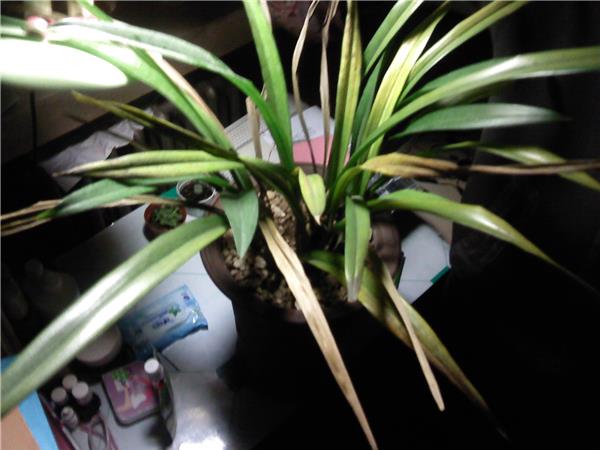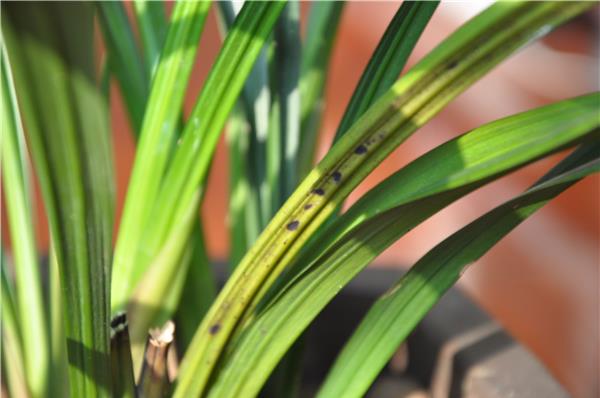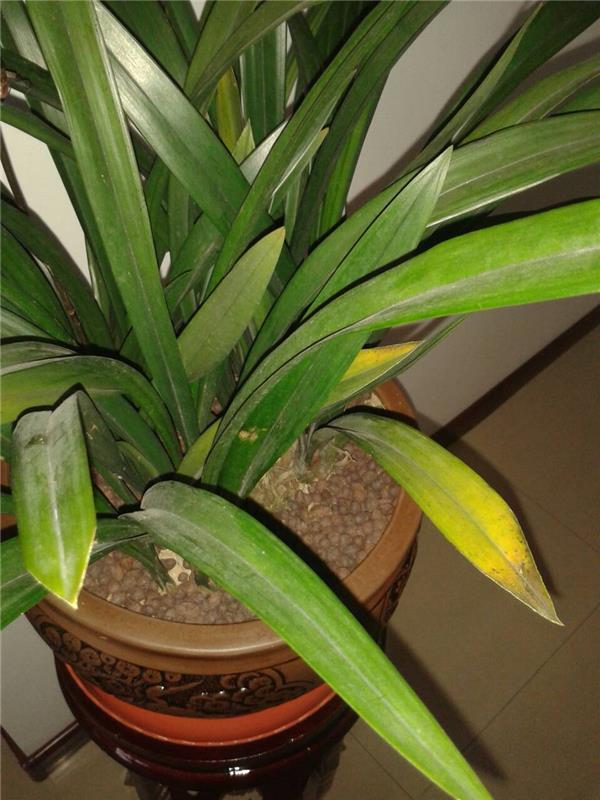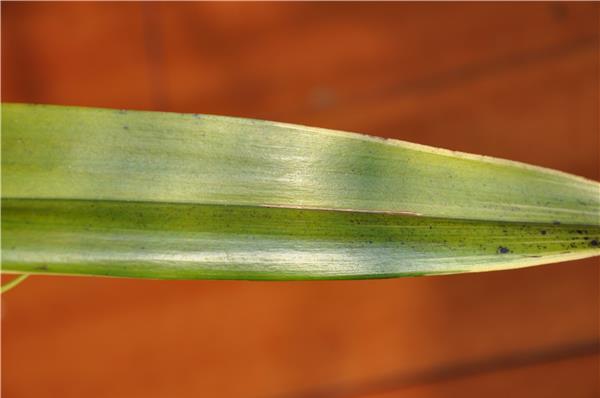[what about the yellowing leaves of Mulan?] how to raise Mulan?
What if the leaves of the orchid turn yellow, rot and wither? The cold tolerance of Magnolia is poor, and potted plants in the north of the Yangtze River Basin often overwinter indoors. Due to low temperature in winter, soil hardening, excessive watering, fertilizer damage, etc., it is often easy to cause rotten roots, light ones affect its normal growth and budding and flowering, serious ones will lead to the death of the whole plant.
What if the leaves of Cymbidium turn yellow?
Please note that the difference between the water temperature and the soil temperature is not too big, otherwise the leaves will be damaged. The fertilization of Cymbidium can be applied in the vigorous growth season after May in spring, and should not be applied in winter and summer. The propagation of Cymbidium was carried out at the same time as changing pots, after anthesis or between September and October. Generally, there should be at least 2-3 false bulbs in each new plant, and do not plant a single seedling.
The leaves of the orchid turn yellow because the roots are affected, or there is too much water, or too little, usually spray more basin water, less watering. In winter, northern cities raise ink orchids indoors, watering them once every 20 days, and usually spray basin noodles with foliar water. Also, don't get too close to the heating. The growth temperature of ink orchids is 10 to 25 degrees Celsius. If there are conditions at home, put them in a place with high humidity (don't put them in the bathroom), no conditions. Just put some water next to Mo Lan to improve the environment. Finally, we should pay attention to basking in the sun, so blossom quickly, see the flowers, you don't have to bask in the sun.

The root rot of Cymbidium mainly depends on the color of leaves and potted soil. When the weather is warm in spring, the leaves of Cymbidium plant gradually lose their oil-green luster, and if the leaves are dry, hard and wrinkled, it can be preliminarily concluded that the roots of the plant have rotted. Secondly, when the weather is fine, the pot soil does not turn white and dry for a few days, which also indicates that the fleshy root of the plant has lost the function of absorption. Of course, in order to accurately judge the degree of root rot, the plant must be removed from the flowerpot before it can be finally determined.
The treatment method of rotten roots of Meilan is to change pots and trim to remove rotten roots and empty sand to promote roots. When it is preliminarily determined from the leaf surface and potted soil that the roots of potted Cymbidium plants are decaying, the orchid plants can be poured out from the pot, and the rotting position and damage degree of the roots can be seen directly. At this time, it is necessary to cut off the moldy, blackened and hollow roots in time, retain the unrotten parts, and remove some leaves with disease spots at the same time. As long as the water-like pseudobulb has not yet rotted, the plant can generally be resurrected. In order to prevent the plant from infecting germs, it is necessary to replace a clean plain tile pot when replanting, and choose non-polluting plain sand planting. When planting, just cover the base of the false bulb with plain sand, do not cover the false bulb, and finally cover the sand with a layer of clean soil or moss, and then put the replanted potted orchid in a cool, ventilated and moderately shaded place. in the process of root regeneration, there is generally no fertilization, and rainstorm irrigation must be prevented until the basal leaves turn green and the leaves stand erect, and there are buds at the base of the bulbs. Before the normal management of water and fertilizer can be restored, this process will take about 4 months.

Rain Water or snow water is the best water for ink orchid. If it is necessary to water the orchid with tap water, it should be exposed to the sun for a day before it can be used. Watering with a spray can, do not spray water into the buds, so as not to cause rot. Avoid showers in summer and must use film to keep out the rain.
The watering time for Mulan should be around sunset in summer and autumn, and the leaves should be dry before nightfall. In winter and spring, it is best to water before and after sunrise, and spray to increase air humidity to benefit the growth of ink orchid. Mo Lan fertilization "should be light and avoid thick", generally start at the end of spring and stop at the end of autumn. Fertilization temperature of 18 degrees Celsius-25 degrees Celsius is appropriate, rainy days are not suitable for fertilization. Types of fertilizers, organic or inorganic fertilizers are available. Cymbidium is fertilized once a week in the growing season, and it grows slowly in autumn and winter. It should be applied less every 20 days, and a small amount of water should be sprayed after fertilization to prevent the leaves from being contaminated by fertilizer. Fertilization must be carried out in the evening on a sunny day, and there is a risk of rotting roots on cloudy days.
The culture method of Cymbidium:
1. Plant material preparation:
The soil quality of Cymbidium requires slightly acidic soil rich in humus, which can be cultivated with plant materials with a pH value of 5.5-6.5, such as rotten leaf soil in the forest, coarse sand in the river, sawn wood, charcoal powder, decaying bark, broken bricks, grain husks, water moss, edible mushroom waste and so on.
2. Orchid basin selection:
The commonly used orchid pots are mud basin, pottery basin, glaze basin and plastic basin, which are not only suitable for the ground, but also suitable for balcony, roof and indoor. Family orchid cultivation is mainly ornamental, with the basin had better use purple sand basin or plastic basin. Orchid special purple sand basin, mostly high foot trumpet-shaped, the bottom edge is porous, hydrophobic and breathable, the shape is unique. The plastic basin is deep, porous, light, neat, cheap, easy to move and reduce floor pressure.

3. Lighting:
Orchids prefer semi-shady environment and avoid dryness. The sun is weak in winter and soft in spring, which is suitable for orchid growth and can accept full light. From early summer to mid-autumn, the light time is long and the light quality is strong, which is disadvantageous to the growth of orchids and needs shading. It is appropriate to put under the tree shade or under the eaves, or the sun can be seen in the morning and evening, there is no sunshine after 9: 00 in the morning, or where there is skylight but no sunshine.
4. Temperature:
The suitable temperature for orchid rooting, sprouting and normal growth is 20 ℃ ~ 28 ℃. The growth was slow below 20 ℃, and the sound was rapid above 25 ℃. When it reached 30 ℃, it was forced to go into dormancy. The dormancy period is 10 ℃ ~ 16 ℃ in day temperature and 5 ℃ ~ 10 ℃ in night temperature. Ink orchid can withstand a low temperature limit of minus 2 ℃. Most families raise orchids to survive the winter indoors, and they can safely survive the severe cold period without taking heating measures in winter and spring. If overwintering in the courtyard or balcony leeward, plastic film can be used to build a temporary greenhouse.
5. Humidity:
The air humidity needed for orchid cultivation requires 60% Mur80% during the growing period and no less than 50% dormancy in winter. Different orchid species have different requirements for air humidity. With low temperature and slow evaporation of water in spring, spraying is generally adopted, which can not only increase the air humidity in the indoor or orchid shed, but also clean the orchid leaves to make them green and fresh.

6. Upper basin
After the basin is selected, before planting, cover the drainage hole at the bottom of the basin with large pieces of broken tiles, spread with window screen, and then cover with coarse grains of mountain mud, and then put into the orchid plant (the distribution of the root system of the orchid plant should be uniform and stretch, do not touch the basin wall). Then fill the basin with humus soil and bury it at the leaf base of the false bulb. And cover the mud surface with a layer of white stone or green cloud grass, which is not only beautiful but also keeps the topsoil moist. Then use the basin bottom water infiltration method to make the soil wet, rinse the foliar soil with a spray can, place the seedlings in the shade place, and transfer to normal management a week later.
7. Management
Cymbidium is a semi-negative plant, which requires "warm, moist, astigmatic and ventilated" environmental conditions. Growth depends on maintenance and management. The cultivation site requires good ventilation and shading facilities. The water requirement of Melanias mainly depends on the air temperature, light intensity and plant growth. In the appendix of Lanpu, Gao Lian of the Ming Dynasty said, "Pei Lan four precepts": "Spring does not come out, summer is not the day, autumn is not dry, winter is not wet." These twelve-character tricks are indeed the experience of raising orchids. Rain Water or snow water is the best water for ink orchid. If it is necessary to water the orchid with tap water, it should be exposed to the sun for a day before it can be used. Watering with a spray can, do not spray water into the buds, so as not to cause rot. Avoid showers in summer and must use film to keep out the rain. Watering time, summer and autumn before and after sunset, before night leaf drying is appropriate. In winter and spring, it is best to water before and after sunrise, and spray to increase air humidity to benefit the growth of ink orchid.
Avoid dryness. The sun is weak in winter and soft in spring, which is suitable for orchid growth and can accept full light. From early summer to mid-autumn, the light time is long and the light quality is strong, which is disadvantageous to the growth of orchids and needs shading. It is appropriate to put under the tree shade or under the eaves, or the sun can be seen in the morning and evening, there is no sunshine after 9: 00 in the morning, or where there is skylight but no sunshine.
4. Temperature:
The suitable temperature for orchid rooting, sprouting and normal growth is 20 ℃ ~ 28 ℃. The growth was slow below 20 ℃, and the sound was rapid above 25 ℃. When it reached 30 ℃, it was forced to go into dormancy. The dormancy period is 10 ℃ ~ 16 ℃ in day temperature and 5 ℃ ~ 10 ℃ in night temperature. Ink orchid can withstand a low temperature limit of minus 2 ℃. Most families raise orchids to survive the winter indoors, and they can safely survive the severe cold period without taking heating measures in winter and spring. If overwintering in the courtyard or balcony leeward, plastic film can be used to build a temporary greenhouse.
5. Humidity:
The air humidity needed for orchid cultivation requires 60% Mur80% during the growing period and no less than 50% dormancy in winter. Different orchid species have different requirements for air humidity. With low temperature and slow evaporation of water in spring, spraying is generally adopted, which can not only increase the air humidity in the indoor or orchid shed, but also clean the orchid leaves to make them green and fresh.

6. Upper basin
After the basin is selected, before planting, cover the drainage hole at the bottom of the basin with large pieces of broken tiles, spread with window screen, and then cover with coarse grains of mountain mud, and then put into the orchid plant (the distribution of the root system of the orchid plant should be uniform and stretch, do not touch the basin wall). Then fill the basin with humus soil and bury it at the leaf base of the false bulb. And cover the mud surface with a layer of white stone or green cloud grass, which is not only beautiful but also keeps the topsoil moist. Then use the basin bottom water infiltration method to make the soil wet, rinse the foliar soil with a spray can, place the seedlings in the shade place, and transfer to normal management a week later.
7. Management
Cymbidium is a semi-negative plant, which requires "warm, moist, astigmatic and ventilated" environmental conditions. Growth depends on maintenance and management. The cultivation site requires good ventilation and shading facilities. The water requirement of Melanias mainly depends on the air temperature, light intensity and plant growth. In the appendix of Lanpu, Gao Lian of the Ming Dynasty said, "Pei Lan four precepts": "Spring does not come out, summer is not the day, autumn is not dry, winter is not wet." These twelve-character tricks are indeed the experience of raising orchids. Rain Water or snow water is the best water for ink orchid. If it is necessary to water the orchid with tap water, it should be exposed to the sun for a day before it can be used. Watering with a spray can, do not spray water into the buds, so as not to cause rot. Avoid showers in summer and must use film to keep out the rain. Watering time, summer and autumn before and after sunset, before night leaf drying is appropriate. In winter and spring, it is best to water before and after sunrise, and spray to increase air humidity to benefit the growth of ink orchid.
Related
- Wuhan Hospital Iron Tree Blooming Result Was Instantly Frightened by the Gardener Master
- Which variety of camellia is the most fragrant and best? Which one do you like best?
- What is the small blue coat, the breeding methods and matters needing attention of the succulent plant
- Dormancy time and maintenance management of succulent plants during dormancy
- Minas succulent how to raise, Minas succulent plant pictures
- What are the varieties of winter succulent plants
- How to raise succulent plants in twelve rolls? let's take a look at some experience of breeding twelve rolls.
- Attention should be paid to water control for succulent plants during dormant period (winter and summer)
- Watering experience of twelve rolls of succulent plants
- Techniques for fertilizing succulent plants. An article will let you know how to fertilize succulent plants.



